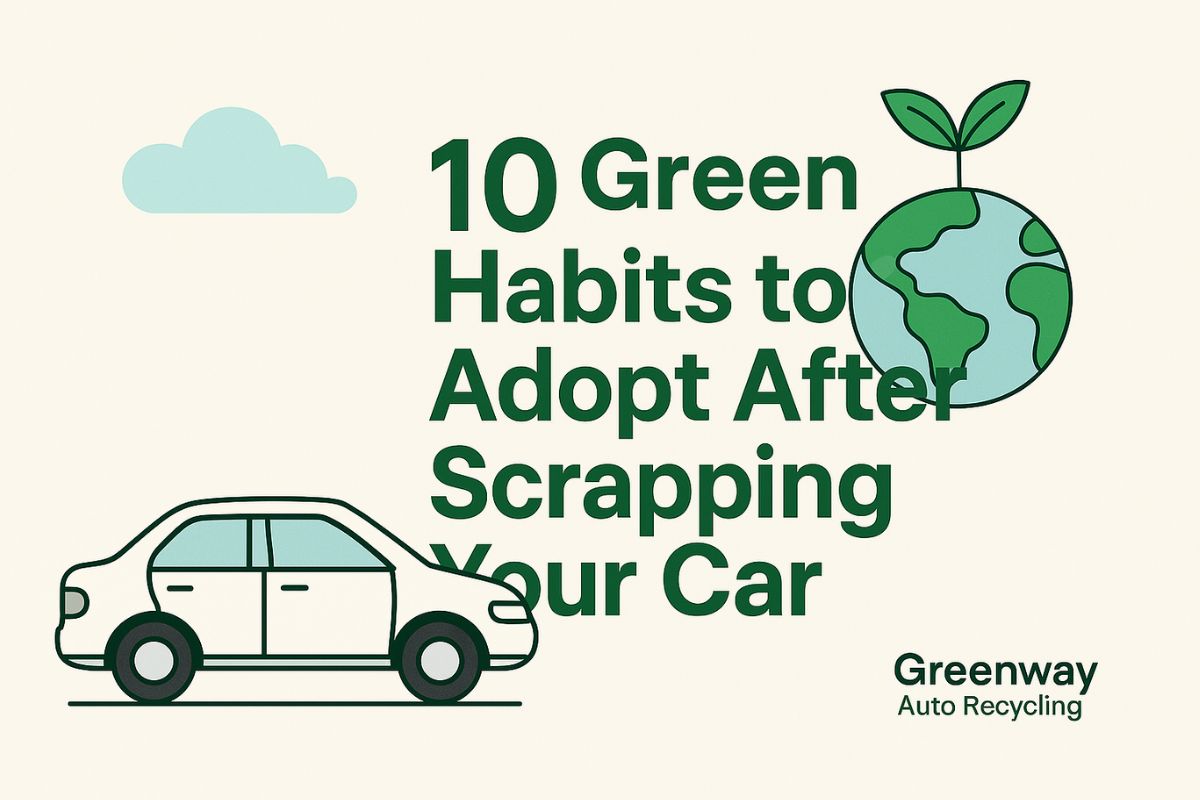Introduction
Scrapping your old car is a smart first step toward living a greener life. Old vehicles often release more harmful emissions and consume more fuel. By removing your car from the road, you help reduce pollution and save energy. But your efforts shouldn’t stop there. Many people scrap their cars and then return to choices that harm the environment again. If you want to make a real difference, you need to build new habits after scrapping your car.
Living in Canada, especially in urban areas like the Greater Toronto Area, gives you access to many green alternatives. You can find better ways to travel, reduce waste, and save energy daily. In this blog, you will learn 10 practical and effective ways to lower your carbon footprint after scrapping your vehicle. Every method is easy to follow, so let’s explore how you can continue protecting the planet long after your old car is gone.
1. Use Public Transportation Regularly
Public transportation is one of the best ways to reduce your daily carbon emission. Buses, streetcars, and trains carry many passengers at once, which means fewer cars running on the road. Fewer cars lead to lower fuel use and fewer greenhouse gas emissions.
In the GTA, services like the TTC, GO Transit, and York Region Transit offer wide coverage. These transit systems are reliable and cost-effective. Instead of driving, you can buy a monthly pass or use a Presto card to ride across the city.
Even using public transport 3–4 times a week makes a big difference. It also helps ease traffic, saves fuel, and lowers the demand for new roads.
2. Switch to a Bicycle or E-Bike
Biking is not just for fitness. It’s a clean way to travel that doesn’t release any harmful gases. If you live within 10 kilometers of your workplace, then switching to a regular bicycle or e-bike can save both money and the environment.
E-bikes are a great option if you have longer distances or uphill routes. They use electric power, which is much cleaner than gasoline. In cities like Toronto and Mississauga, bike lanes have expanded, making it safer to ride.
You also save on fuel, parking, and maintenance. Many people in urban areas now use bikes as their main transport for short trips.
Also Read: How Non-Metallic Car Parts Are Recycled and Repurposed for a Greener Future
3. Walk More for Short Trips
You don’t need a car for short trips. You can walk to the store, post office, or local cafe and get some fresh air at the same time. Walking doesn’t cost a penny, doesn’t pollute the environment, and keeps you healthy.
Look at how often you use a car for trips under 2 kilometers. Replace those with walking, and you will avoid unnecessary emissions. Use Google Maps to check walk times and routes near your home or work.
Plan your routes using apps like Google Maps or AllTrails. You’ll also discover local spots that you might miss while driving.
4. Carpool or Rideshare When Needed
Sometimes, you might still need a car for a road trip, a client meeting, or when public transport isn’t an option. In these cases, consider carpooling or ridesharing. Carpooling cuts fuel use, reduces costs, and lowers the number of cars on the road.
You can use apps like UberX, Poparide, or even set up rides with coworkers or neighbors going the same way. Some offices and colleges in the GTA already run carpool programs. Check if your workplace or university supports this option.
5. Switch to Renewable Energy at Home
You have removed your car, which helps. But what about your electricity use at home? If your power comes from gas or coal, it still adds to your carbon footprint.
In Ontario, companies like Bullfrog Power offer green energy plans. These providers let you buy clean power for your home. It may cost slightly more, but the environmental benefit is much higher.
If you own your home, you can also look into solar panels. The upfront cost is higher, but you will cut down power bills and emissions over the years. The federal and provincial governments offer rebates, too.
6. Buy Energy-Efficient Appliances
Old appliances waste electricity. Fridges, ACs, washing machines, and even light bulbs can use more power than they should. That extra energy adds to your carbon footprint.
Buy Energy Star- rated appliances when you upgrade. They’re built to use less energy without losing performance. Also, switch your lights to LED bulbs; they last longer and use much less electricity.
Yes, there is a cost upfront, but you will save on power bills in the long run. You also help reduce the pressure on your city’s energy supply.
Also Read: 20 Amazing Facts About Scrap Car Recycling
7. Cut Down on Single-Use Plastics
Plastic pollution is a big issue in Canada and worldwide. After scrapping your car, take a close look at your plastic use. Single-use items like straws, plastic forks, water bottles, and shopping bags cause long-term harm.
Canada has already banned many single-use items like straws, bags, and cutlery. You can go further. Carry your own cloth bag, water bottle, or food container when you go out.
Refuse plastic where you can. Choose products with simple or no packaging. These small changes help reduce waste and lower your carbon footprint.
8. Recycle and Compost Properly
Recycling helps reduce the demand for raw materials, while composting cuts down the waste that goes to landfills. In landfills, food waste produces methane, a powerful greenhouse gas.
You can stop that by using your green bin for compost and your blue bin for recycling. Learn your city’s sorting rules so you don’t throw the wrong items in the wrong bin. If you live in an apartment or condo, ask your building manager if composting bins are available.
9. Shop Local and Eat Seasonal
Imported goods, especially food, travel long distances by truck, ship, or plane. That transport creates a big carbon footprint. Instead, support local businesses and farmers.
Buy food grown in Ontario. Shop at farmers’ markets like St. Lawrence Market, Mississauga Farmers Market, or local farm stands. Seasonal fruits and veggies are fresher, tastier, and need less energy to store or ship. You also help small farms and local jobs. And when you avoid over-packaged imports, you reduce plastic waste, too.
10. Support Eco-Friendly Businesses
Think about where you spend your money. Support brands that care about the planet. Many Canadian companies now use recycled materials, reduce packaging, and follow clean supply chains.
Look for businesses that use recycled materials, offer carbon-neutral delivery, or plant trees for every product sold. Many Canadian brands now focus on sustainable products, from clothing to furniture. You can also write reviews, share their social media, or gift their items to friends. Every small act creates a bigger impact.
Conclusion
Scrapping your car was a great first step. But real change comes from what you do next. Use public transit, walk more, bike when you can, recycle correctly, and choose clean energy. Each of these steps brings your carbon footprint down even further. If you haven’t scrapped your old car yet, or if someone you know still needs to, go with Greenway Auto Recycling. They offer fast and reliable scrap car removal in GTA areas. Their team makes sure every car is handled responsibly, with proper recycling and safe disposal.
By scrapping your car with Greenway Auto Recycling and following the tips in this blog, you will take strong steps toward a cleaner, greener future for yourself and Canada.





